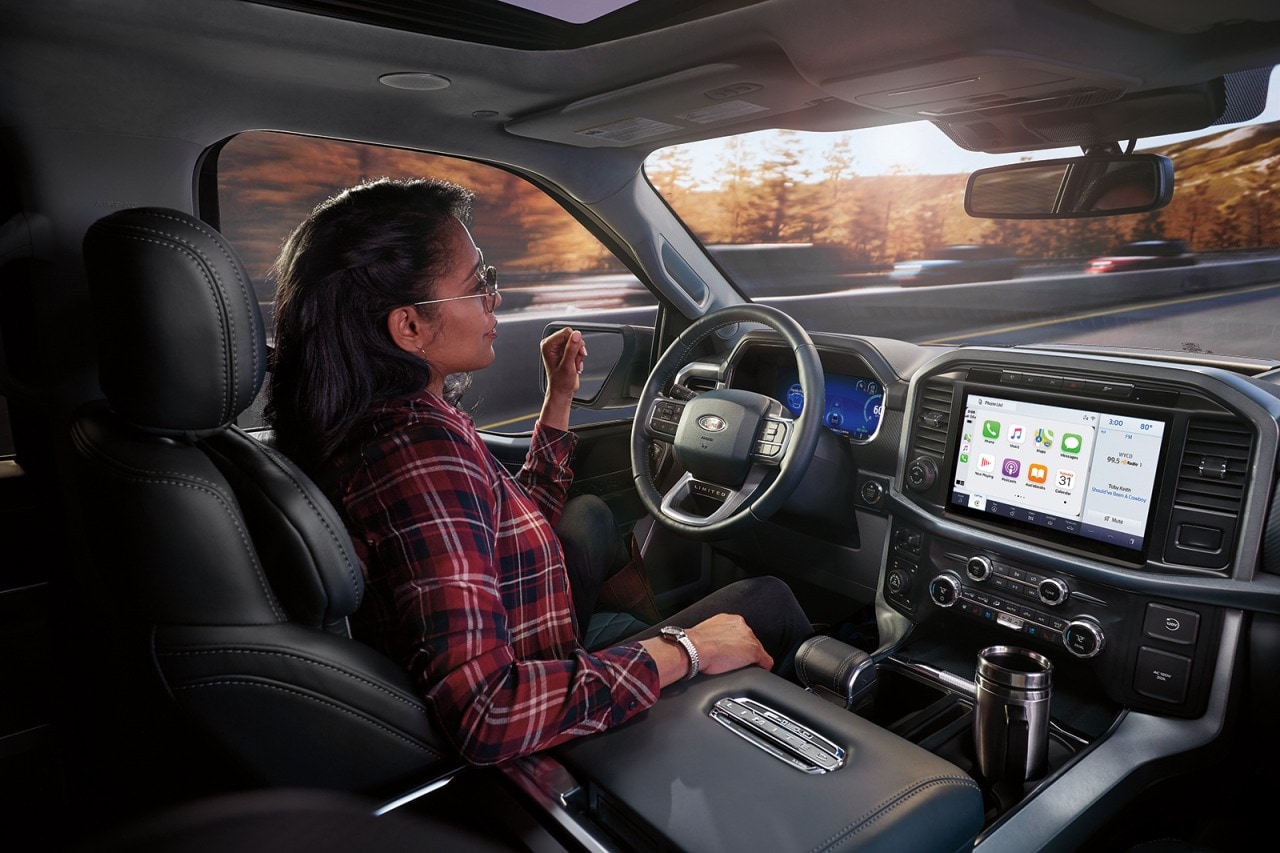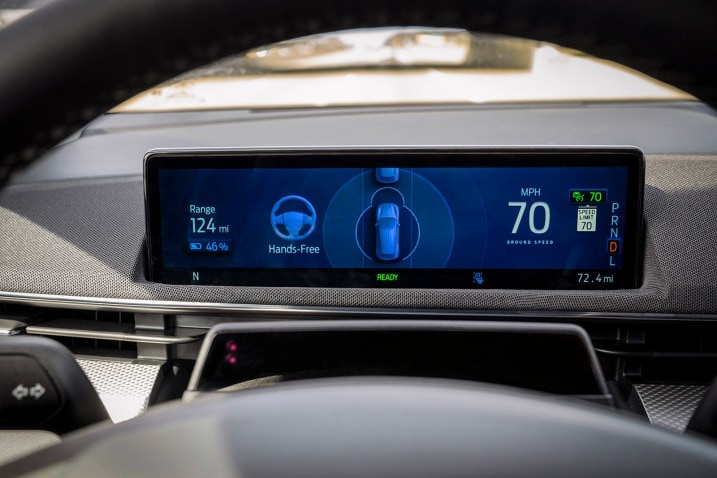- Ford's hands-free BlueCruise tech is coming to the 2021 Mustang Mach-E and F-150 later this year.
- We've driven both vehicles with BlueCruise equipped, so we're here to tell you what it's like on the road.
We Tested Ford's BlueCruise Hands-Free Driving and Here's What It's Like
I, for one, embrace our new robotic overlords
General Motors got the jump on its rivals when it unveiled Super Cruise back in 2018, taking features like adaptive cruise control and lane centering to new heights with a hands-free mode that only works on certain premapped highways. Now Ford is getting into the hands-free game with its BlueCruise technology suite.
Is this a case of better late than never? Join us as we take an in-depth look at how BlueCruise works and — based on our seat time in an F-150 and a Mustang Mach-E — what it's like on real American roads.
How does Ford's BlueCruise work?
BlueCruise operates on the same principle as Super Cruise. Once the vehicle is traveling on one of the 100,000 miles of qualified roadways (Ford dubs these Hands-Free Blue Zones) and certain conditions have been met, a graphic appears in the instrument panel to let you know that BlueCruise is ready for activation. Simply press the cruise control button on the steering wheel and you can take your hands off the wheel to let the vehicle drive itself.
Like Super Cruise, Ford's BlueCruise system is not autonomous. As the driver, you have to be alert and prepared to take the wheel at any time. BlueCruise will not take evasive action if there is a small obstruction in the road — a box on the freeway, for instance — and you must be ready to perform advanced maneuvers if necessary. To that end, BlueCruise includes a head and eye position sensor to make sure you're watching the road ahead. Divert your attention for too long and the system will deactivate. And because BlueCruise relies on clearly visible lane markers, traveling on highway sections that lack them will deactivate the system.
With these limitations in mind, here are the first vehicles to receive BlueCruise — and we've driven both, so keep reading to find out what BlueCruise is like in the real world.
Which Ford vehicles have BlueCruise?
Am I Ready for an EV?
- EV ownership works best if you can charge (240V) at home or at work This typically means a 240V home installation, but you could also have a similar setup at your office or other places your car is already parked for several hours each day. Don't expect a regular household outlet (120V) to suffice unless you've got a plug-in hybrid, in which case overnight charging at home is feasible.
- If you can’t charge at home, charging at a charging station could take at least 10x longer than at a gas station With public charging infrastructure still in its infancy, the user experience can be maddeningly inconsistent. Tesla owners tend to rave about the reliability and speed of the company's proprietary Supercharger stations, but rival DC fast options have thus far been plagued by technical issues and overcrowding. It's an evolving landscape and our best advice is to do your research on the available options for the EV you want to buy.
- Adding a 240V home charging system could cost up to $1,600 or more If your existing electrical service can handle the additional demands of EV charging, you may be able to add Level 2 charging at home for less than a grand, including installation. But your costs will multiply if you need to upgrade your electrical panel or add a dedicated circuit.
The first vehicles to receive BlueCruise functionality will be two of Ford's newest models — the 2021 Ford Mustang Mach-E and 2021 Ford F-150. In both cases, the BlueCruise hardware is tied to the Ford Co-Pilot360 Active 2.0 package.
For the Mustang Mach-E, all trims except the base Select model come standard with Co-Pilot360 Active 2.0, while the Select can get it as part of the optional Comfort/Technology package. Buyers speccing out fully loaded F-150s will find that Co-Pilot360 Active 2.0 is already included in the top-trim Limited model. The package is also available on the Lariat, King Ranch and Platinum trims.
Each 2021 Ford vehicle with the Co-Pilot360 Active 2.0 package will be outfitted with the hardware necessary to activate BlueCruise. However, BlueCruise isn't available just yet — it'll come online in the next few months via an over-the-air software update. For Co-Pilot360 Active 2.0-equipped models produced earlier in the 2021 model year, the hardware is included, and to activate BlueCruise, you'll have to pay a subscription fee. That fee is $600, which will cover the first three years of service. Models with the above package that launch after the software comes online will come with both the hardware and the software (though the price of the vehicle may rise with the software's inclusion).
Though we don't love the idea of subscriptions services in vehicles overall, it makes sense for Ford to charge a recurring rate. BlueCruise will constantly be updated with improvements to expand coverage and add features. For example, automated lane changes and slowing down for upcoming road curves are already being planned as post-launch additions.
What is BlueCruise like on the road?
I had the opportunity to drive both an F-150 and Mustang Mach-E with BlueCruise, and there was no functional difference in how the system behaved in each vehicle. The system itself melds several driver aids that are already present on the majority of cars today, but with a head- and eye-tracking component that makes sure you're paying attention. Once this is established — and you're driving on a preapproved road — a ring will appear around a graphic of the vehicle in the digital instrument panel. This lets you know that BlueCruise is ready to activate. Simply press the cruise control button and acceleration, braking and turning is handed over to BlueCruise.
In this way, BlueCruise functions similarly to GM's Super Cruise. The primary difference is that GM vehicles with Super Cruise have an LED light bar integrated into the steering wheel to let you know when Super Cruise can be activated. Ford's system isn't so obvious in letting you know when it's ready. When you press the cruise control button, however, the instrument panel graphics turn blue to inform you that BlueCruise is active and you can take your hands off the wheel.
The other difference between the two competing systems is that GM's Super Cruise has one prescribed distance for the adaptive cruise control (ACC) aspect. Ford has decided to treat BlueCruise like a typical ACC system in which you can choose one of four following distances.
When engaged, BlueCruise does a good job at approximating typical human driving behavior. I never had to adjust the following distance from one of the medium settings, and the system gives you a few beats to put your hands on the wheel when it needs you to resume control.
I didn't experience many technical issues in either vehicle on my limited test drive, but there was one instance in which I was forced to make an emergency maneuver. A Civic driver with little concern for their personal safety accelerated to merge right in front of my F-150, and the truck didn't slow down quickly enough. This wasn't necessarily a fault of BlueCruise itself — I have found that ACC systems in general are slow to react to vehicles merging into or out of my lane — but it goes to show that you still need to have your wits about you at all times.
Edmunds says
Like GM's Super Cruise, Ford's BlueCruise provides a hands-free driving experience on certain limited-access highways. It certainly takes some stress out of driving in bumper-to-bumper traffic, and should be similarly pleasant on long-distance road trips. But these are not autonomous systems, and drivers need to be ready to take the wheel at any time to react to changing road conditions.







 by
by